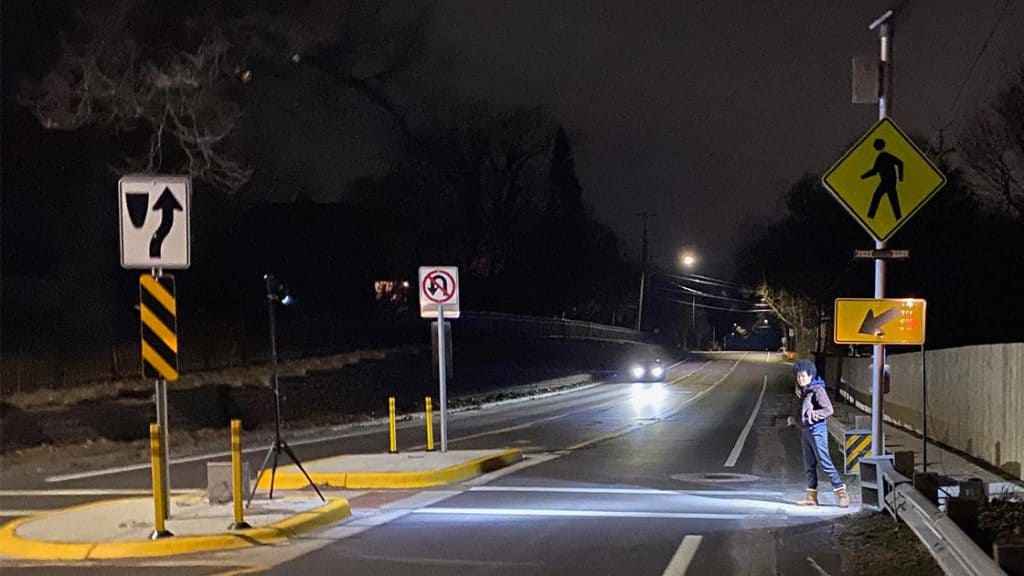
“These results show that simple changes can have a dramatic impact on pedestrian safety,” IIHS President David Harkey said. “When drivers are yielding, pedestrians aren’t dying.”
About 75% of the 7,522 pedestrians who died in motor vehicle crashes in 2022 were killed in the dark, suggesting that improved lighting could help stem the rising tide of pedestrian fatalities.
To help identify the most effective interventions, researchers from IIHS and Western Michigan University compared the effects of different crosswalk lighting systems at two T intersections, a four-way intersection and a midblock location in Kalamazoo, Michigan. None of the locations had a stop sign or traffic signal. The crosswalk at one of the T intersections featured a rectangular rapid flashing beacon (RRFB). RRFBs are yellow LEDs mounted to pedestrian or bicycle crossing signs that flash intermittently when activated by a person attempting to cross.
The existing streetlights at the midblock location provided 20 lux of illumination, as federal guidelines suggest for midblock crosswalks, while illumination at the three intersections was less than 3 lux.
At all four locations, the researchers tested the effects of a commercial crosswalk illuminator when it was set to provide light on a constant basis and when it was set to come on only when triggered by a pedestrian. At the site with the RRFB, they also tested the effect of the beacon alone and combined with the triggered illuminator.
In contrast to overhead streetlights, crosswalk illuminators are LED floodlights that shine horizontally across the street. The model the researchers used provided 20 lux of vertical illumination at the crosswalk entrance.
In general, the researchers found that any type of added lighting or flashing beacons improved yielding at the three dark locations. However, yielding was highest with the combination of flashers and triggered crosswalk lighting.
“These results show that crosswalk lighting and flashing beacons make pedestrians substantially safer in poorly lit areas,” said study author Wen Hu, IIHS senior research transportation engineer. “Along with lower speed limits and road designs that discourage speeding, these simple solutions have the potential to reduce pedestrian injuries and fatalities.”
At the first two locations, a dimly lit T intersection and a dimly lit four-way intersection with a 30 mph speed limit, drivers were more than 3 times as likely to yield to pedestrians with continuous crosswalk lighting or triggered illuminators in place, compared with no added lighting. The likelihood that drivers slowed by more than 10 mph at the crosswalk — whether or not they yielded to the pedestrian — also tripled when one of the two crosswalk lighting systems was installed.
At the third site, a brightly lit midblock location where the speed limit was 25 mph, the addition of crosswalk lighting didn’t make a statistically significant difference in the likelihood drivers would yield to pedestrians.
At the fourth site, a dimly lit T intersection with RRFBs and a 30 mph limit, drivers were more than 13 times as likely to yield to pedestrians when RRFBs and triggered crosswalk lighting were both activated, compared with no added lighting or beacons. They were also more than twice as likely to yield when both RRFBs and triggered lighting were activated than when either RRFBs or triggered lighting was activated by itself.
That’s not surprising, as prior research has shown that RRFBs get drivers’ attention but don’t help them to see pedestrians. The combination of RRFBs with crosswalk lighting presumably accomplishes both goals — though that’s something that needs to be confirmed with further research at additional sites.
“Solutions aren’t always complicated,” Harkey said. “We can stop pedestrians from being killed if we make sure drivers see them — but first city planners and road designers have to see the light.”